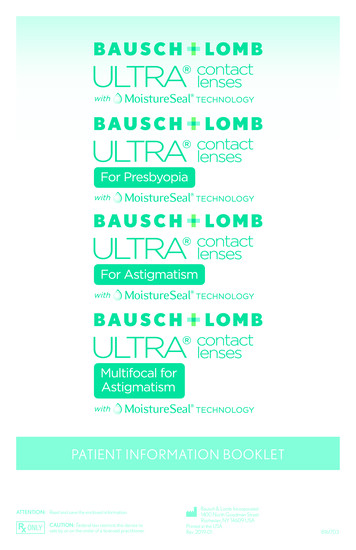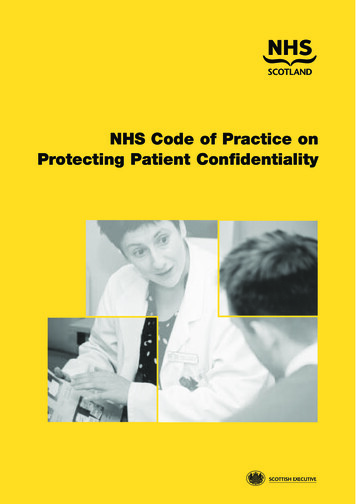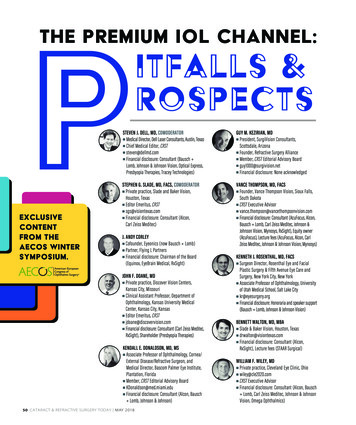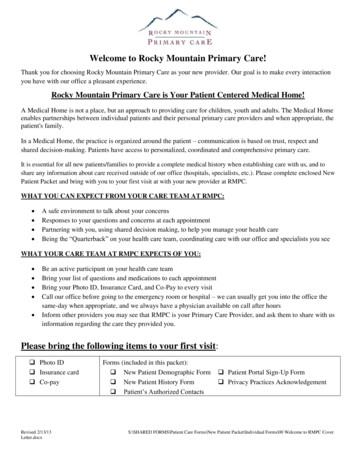
Transcription
PATIENT INFORMATION BOOKLETATTENTION: Read and save the enclosed information.CAUTION: Federal law restricts this device tosale by or on the order of a licensed practitioner.Bausch & Lomb Incorporated1400 North Goodman StreetRochester, NY 14609 USAPrinted in the USARev. 2019-018161703
PATIENT INFORMATION BOOKLETTABLE OF CONTENTSIntroduction.4Wearing Restrictions and Indications.4Contraindications (Reasons Not To Use). 5Warnings. 5Precautions. 5Adverse Reactions (Problems and What To Do).7Personal Cleanliness and Lens Handling.7Preparing the Lens for Wearing.7Handling the Lenses.7Placing the Lens on the Eye. 8Centering the Lens. 8Removing the Lens. 9Lens Wearing Schedules. 9Caring for Your Lenses (Cleaning, Rinsing, Disinfecting, Enzyming, Storage and Rewetting/Lubricating). 9Soaking and Storing Lenses. 9Rub and Rinse Time. 9Lens Case Care.10Water Activity.10Discard Date on the Solution Bottle.10Basic Instructions.10Chemical (Not Heat) Disinfection.10Lens Deposits and Use of Enzymatic Cleaning Procedure.10Care for a Sticking (Nonmoving) Lens.11Care for a Dried Out (Dehydrated) Lens.11Emergencies.11Lens Care Product Chart.11Instructions for the Monovision or Multifocal Wearer.12Personal Wearing Schedule Record. 13Check-Up Visits.14Visit Schedule.14Eye Care Practitioner Information.14Glossary of Medical Terms. 15Symbol Reference Guide. 15
INTRODUCTIONIf problems or symptoms should occur, immediatelyremove your lenses and follow the steps described inthe section of this booklet entitled WARNINGS andADVERSE REACTIONS (PROBLEMS AND WHAT TODO). (Refer to GLOSSARY OF MEDICAL TERMS fordescription of medical terms used in this booklet). Promptattention to problems is essential and may require immediateprofessional care.Remember, when wearing soft contact lenses your eyesshould look and feel good, and your vision should be clear.The instructions in this booklet apply to the Bausch LombULTRA (samfilcon A) Contact Lenses. If you have receivedor are considering another brand of contact lenses, do notuse this booklet. Ask your eye care practitioner for the patientbooklet or instructions that apply to your brand or type ofcontact lenses. For Bausch Lomb ULTRA (samfilcon A)Contact Lenses, it is essential to your safety that you read andunderstand the information and instructions in this booklet,and have your eye care practitioner answer any questions,both before and after you receive contact lenses.Wearing contact lenses is different from wearing eyeglasses.Because they are worn directly on your eyes, contact lensesaffect the way in which your eyes function. These effects tendto increase with the length of time that the lenses remain onyour eyes between removals. Although the great majority ofpeople successfully wear contact lenses without problems,before you decide whether to begin or to continue wearingcontact lenses for daily wear, you should discuss with youreye care practitioner the effects of contact lenses on youreyes and the risks associated with wearing contact lenses,which are greater with continuous wear contact lens use.You also should read the sections of this booklet entitledWARNINGS, ADVERSE REACTIONS (PROBLEMSAND WHAT TO DO), PRECAUTIONS and WEARINGRESTRICTIONS AND INDICATIONS. Ask your eye carepractitioner to explain anything that you do not understand,including any additional restrictions which may be given toyou by your eye care practitioner.You also need to remember that soft contact lenses, includingthose covered by this booklet, are made of a type of plasticthat absorbs liquids, vapors, and small particles, and, forsome people, may collect deposits from your natural eyefluids. Therefore, you should strictly follow the instructionscontained in the sections of this booklet entitled PERSONALCLEANLINESS AND LENS HANDLING, as well as thewritten information leaflets accompanying the lens careproducts that you buy and any other instructions givento you by your eye care practitioner. Any failure to followthese instructions and the wearing restrictions will increasethe chances of contamination, damage to the lenses, or abuild-up of deposits on the lenses, which can lead to serious,sight-threatening eye infections and injuries.Adherence to your prescribed wearing and replacementschedule, and regular check-up visits to your eye carepractitioner are also necessary for the proper and safe use ofcontact lenses.It is important to not wear your lenses longer thanrecommended by your eye care practitioner sincedoing so increases the risk of adverse effects.Spaces are provided in the back of this booklet for you torecord your personal wearing schedule and schedule offollow-up visits. Soft contact lenses generally are comfortablefrom the beginning. Therefore, be sure to follow the wearingschedule prescribed for you, and do not wear your lensesfor longer periods than your prescribed wearing schedulesimply because they remain comfortable and you are notexperiencing a problem. Only your eye care practitioner,through a professional examination, can determine how youreyes are reacting to the contact lenses and whether there areany early signs of possible problems.WEARING RESTRICTIONSAND INDICATIONSSINGLE VISION SPHERICAL (SVS)VISION CORRECTIONThe Bausch Lomb ULTRA (samfilcon A) Contact Lensis indicated for daily wear or extended wear for up to 7 daysbetween removals for cleaning and disinfection or disposal ofthe lens, as recommended by the eye care practitioner. Thelens is indicated for the correction of refractive ametropia(myopia and hyperopia) in aphakic and/or not-aphakicpersons with non-diseased eyes, exhibiting astigmatism of2.00 diopters or less, that does not interfere with visual acuity.PRESBYOPIA VISION CORRECTIONThe Bausch Lomb ULTRA (samfilcon A) Contact LensFor Presbyopia is indicated for daily wear or extendedwear for up to 7 days between removals for cleaningand disinfection or disposal of the lens, as recommendedby the eye care practitioner. The lens is indicated for thecorrection of refractive ametropia (myopia, hyperopia andastigmatism) and presbyopia in aphakic and/or not-aphakicpersons with non-diseased eyes, exhibiting astigmatism of2.00 diopters or less, that does not interfere with visual acuity.The lens may be prescribed for add powers ranging from 0.75D to 5.00D.ASTIGMATISM VISION CORRECTIONThe Bausch Lomb ULTRA (samfilcon A) Contact Lens forAstigmatism is indicated for daily wear or extended wear forup to 7 days between removals for cleaning and disinfectionor disposal of the lens, as recommended by the eye carepractitioner. The lens is indicated for the correction ofrefractive ametropia (myopia, hyperopia and astigmatism) inaphakic and/or not-aphakic persons with non-diseased eyes,exhibiting astigmatism up to 5.00 diopters.MULTIFOCAL FOR ASTIGMATISMVISION CORRECTIONThe Bausch Lomb ULTRA (samfilcon A) Multifocalfor Astigmatism Contact Lens is indicated for daily wearor extended wear for up to 7 days between removalsfor cleaning and disinfecting or disposal of the lens, asrecommended by the eye care practitioner. The lens isindicated for the correction of refractive ametropia (myopia,hyperopia and astigmatism) and presbyopia in aphakicand/or not-aphakic persons with non-diseased eyes,exhibiting astigmatism of up to 5.00 diopters and require anadd power ranging from 0.75 D to 5.00D.4
Strict compliance with your lens care regimen includingcleaning of the lens case, wearing restrictions, wearingschedule, and follow-up visit schedule must be followed. Daily wear lenses are not indicated for overnight wear,and you should not wear lenses while sleeping. Clinical studies have shown that the risk of seriousadverse reactions is increased when contact lenses areworn overnight. Studies have shown that contact lens wearers who aresmokers have a higher incidence of adverse reactionsthan nonsmokers. If you experience eye discomfort, excessive tearing,vision changes, or redness of the eye, you shouldimmediately remove lenses and promptly contact youreye care practitioner.FREQUENT/PLANNEDREPLACEMENT WEARWhen prescribed for Frequent/Planned ReplacementWear, the Bausch Lomb ULTRA (samfilcon A)Contact Lens is to be cleaned, rinsed and disinfectedeach time it is removed from the patient’s eye anddiscarded after the recommended wearing periodprescribed by the eye care practitioner. The lens maybe disinfected using a chemical disinfection system.DISPOSABLE WEARWhen prescribed for Disposable Wear, theBausch Lomb ULTRA (samfilcon A) Contact Lensis to be discarded after each removal.EXTENDED WEARWEARING RESTRICTIONS The risk of microbial keratitis has been shown to begreater among users of continuous wear contact lensesthan among users of daily wear contact lenses.Some researchers believe that these complications arecaused by one or more of the following: a weakeningof the cornea’s resistance to infections, particularlyduring a closed-eye condition, as a result of hypoxia; aneye environment which is somewhat more conduciveto the growth of bacteria and other microorganisms,particularly when a regular periodic lens removal anddisinfecting or disposal schedule has not been adheredto by the patient; improper lens disinfection or cleaningby the patient; contamination of lens care products; poorpersonal hygiene by the patient; patient unsuitability tothe particular lens or wearing schedule; accumulation oflens deposits; damage to the lens; improper fitting; lengthof wearing time; and the presence of ocular debris orenvironmental contaminants.While the great majority of patients successfullywear contact lenses, continuous wear of lenses alsois reported to be associated with a higher incidenceand degree of epithelial microcysts and infiltrates, andendothelial polymegathism, which require considerationof discontinuation or restriction of continuous wear. Theepithelial conditions are reversible upon discontinuation ofcontinuous wear.The reversibility of endothelial effects of contact lenswear has not been conclusively established. As a result,practitioners’ views of continuous wearing times varyfrom not prescribing continuous wear at all to prescribingflexible wearing times from occasional overnight wear toprescribing continuous wearing periods from up to 7 dayswith specified intervals of no lens wear for certain patients,with follow-up visits, and with proper care regimen. If you experience eye discomfort, excessive tearing,vision changes, or redness of the eye, you shouldimmediately remove lenses and promptly contact youreye care practitioner.The Bausch Lomb ULTRA (samfilcon A) Contact Lensesdescribed in this booklet should be removed from your eyesfor routine cleaning and disinfecting as prescribed by youreye care practitioner. For extended wear, once the lensesare removed, your eyes should have a rest without lenswear for at least one overnight, as recommended byyour eye care practitioner. Your eye care practitionerwill tell you how long to rest your eyes in between wearingperiods and will also recommend a replacement period andappropriate lens care product.CONTRAINDICATIONS(REASONS NOT TO USE)DO NOT USE these lenses when any of the followingconditions exist: Acute and subacute inflammation or infection of theanterior chamber of the eye Any eye disease, injury, or abnormality that affects thecornea, conjunctiva, or eyelids Severe insufficiency of lacrimal secretion (dry eyes) Corneal hypoesthesia (reduced corneal sensitivity) Any systemic disease that may affect the eye or beexaggerated by wearing contact lenses Allergic reactions of ocular surfaces or adnexa(surrounding tissue) that may be induced or exaggeratedby wearing contact lenses or use of contact lens solutions Allergy to any ingredient, such as mercury orThimerosal, in a solution which is to be used to care forBausch Lomb ULTRA (samfilcon A) Contact Lenses Any active corneal infection (bacterial, fungal, or viral) If eyes become red or irritatedWARNINGSYou should be aware of and fully discuss with your eye carepractitioner the following warnings pertaining to contactlens wear: Problems with contact lenses and lens care productscould result in serious injury to your eye. It is essentialthat you follow your eye care practitioner’s direction andall labeling instructions for proper use of lenses and lenscare products, including the lens case. Eye problems,including corneal ulcers, can develop rapidly and lead toloss of vision.PRECAUTIONSYou should be aware of and fully discuss with your eyecare practitioner the following lens care regimen andsafety precautions:SPECIFIC PRECAUTIONS Always discard disposable lenses and lenses worn ona frequent/planned replacement schedule after therecommended wearing schedule prescribed by the eyecare practitioner.5
HANDLING PRECAUTIONS Never use conventional hard contact lens solutions thatare not also recommended for use with prescribed lenses. Do not mix or alternate lens care systems or solutionsunless indicated in the lens care system labeling. Do not heat the chemical disinfection solution or lenses. Always wash and rinse hands before handling lenses.Do not get cosmetics, lotions, soaps, creams, deodorants,or sprays in the eyes or on the lenses. It is best to put onlenses before putting on makeup. Water-based cosmeticsare less likely to damage lenses than oil-based products. Before leaving your eye care practitioner’s office becertain that you are able to remove your lenses promptlyor have someone else available to remove them for you. Be certain that the fingers or hands are free of foreignmaterials before touching your lenses, as microscopicscratches of the lenses may occur, causing distorted visionand/or injury to the eye. Always handle your lenses carefully and avoiddropping them. Do not touch the lens with your fingernails. Carefully follow the handling, insertion, removal,cleaning, disinfecting, storing and wearing instructionsin this booklet and those prescribed by your eyecare practitioner. Never use tweezers or other tools to remove your lensesfrom the lens container unless specifically indicated forthat use. Pour the lens into the hand.LENS CASE PRECAUTIONS Contact lens cases can be a source of bacterial growth.To prevent contamination and to help avoid serious eyeinjury, always empty and rinse the lens case with fresh,sterile rinsing solution and allow to air-dry. Lens cases should be replaced at least every three monthsor as recommended by the lens case manufacturer or eyecare practitioner.TOPICS TO DISCUSS WITH THEEYE CARE PRACTITIONER As with any contact lens, follow-up visits are necessary toassure the continuing health of the eyes. You should beinstructed as to a recommended follow-up schedule. Patients should be advised about wearing lensesduring sporting and water related activities. Exposureto water while wearing contact lenses in activities suchas swimming, water skiing and hot tubs may increasethe risk of ocular infection including, but not limited to,Acanthamoeba keratitis. Always contact your eye care practitioner before usingany medicine in the eyes. Certain medications, such as antihistamines,decongestants, diuretics, muscle relaxants, tranquilizers,and those for motion sickness may cause dryness of theeye, increased lens awareness, or blurred vision. Shouldsuch conditions exist, proper remedial measures shouldbe prescribed. Depending on the severity, this couldinclude the use of lubricating drops that are indicated foruse with soft contact lenses or temporary discontinuanceof contact lens wear while such medication is being used. Oral contraceptive users could develop visual changesor changes in lens tolerance when using contact lenses.Patients should be cautioned accordingly.LENS WEARING PRECAUTIONS Never wear your lenses beyond the periodrecommended by your eye care practitioner. If the lens sticks (stops moving) on the eye, follow therecommended directions on CARE FOR A STICKING(NONMOVING) LENS. The lens should movefreely on the eye for the continued health of the eye.If nonmovement of the lens continues, you shouldimmediately consult your eye care practitioner. Avoid, if possible, all harmful or irritating vapors and fumeswhen wearing lenses. If aerosol products are used while wearing lenses,exercise caution and keep eyes closed until the sprayhas settled.LENS CARE PRECAUTIONSWHO SHOULD KNOW THAT THE PATIENTIS WEARING CONTACT LENSESNote: Eye injury due to irritation or infection may result from lenscontamination. To reduce the risk of contamination, review theappropriate manufacturer’s labeled lens care instructions withthe patient. Inform your doctor (health care professional) about beinga contact lens wearer. Always inform your employer of being a contact lenswearer. Some jobs may require the use of eye protectionequipment or may require that you not wear lenses.Ask your eye care practitioner whether there are any otherwearing restrictions that apply to you. Write those restrictionsin the spaces provided below and follow them carefully: Always use fresh, unexpired lens care solutions. Always follow directions in the package inserts for the useof contact lens solutions. Sterile unpreserved solutions, when used, shouldbe discarded after the time specified in the labelingdirections. Always keep the lenses completely immersed in therecommended storage solution when lenses are not beingworn (stored). Prolonged periods of drying will damagelenses. Follow the lens care directions for CARE FORA DRIED OUT (DEHYDRATED) LENS if lens surfacedoes become dried out. Do not use saliva or anything other than therecommended solution for lubricating or wetting lenses. Tap water, distilled water or homemade saline shouldnot be used as a substitute for any component in the lenscare regimen since they have been associated with anAcanthamoeba keratitis infection.6
ADVERSE REACTIONS(PROBLEMS ANDWHAT TO DO)PERSONAL CLEANLINESSAND LENS HANDLING1. PREPARING THE LENS FOR WEARINGIt is essential that you learn and use good hygienic methodsin the care and handling of your new lenses. Cleanliness isthe first and most important aspect of proper contact lenscare. In particular, your hands should be clean and free ofany foreign substances when you handle your lenses. Theprocedures are: Always wash your hands thoroughly with a mild soap,rinse completely, and dry with a lint-free towel beforetouching your lenses. Avoid the use of soaps containing cold cream, lotion, oroily cosmetics before handling your lenses, since thesesubstances may come into contact with the lenses andinterfere with successful wearing. Handle your lenses with your fingertips, and be carefulto avoid contact with fingernails. It is helpful to keep yourfingernails short and smooth.Start off correctly by getting into the habit of always usingproper hygienic procedures so that they become automatic.YOU SHOULD BE AWARE THAT THEFOLLOWING PROBLEMS MAY OCCUR: Eyes stinging, burning, itching (irritation), or other eye pain Comfort is less than when lens was first placed on eye Abnormal feeling of something in the eye (foreign body,scratched area) Excessive watering (tearing) of the eyes Unusual eye secretions Redness of the eyes Reduced sharpness of vision (poor visual acuity) Blurred vision, rainbows, or halos around objects Sensitivity to light (photophobia) Dry eyesIf you notice any of the above, YOU SHOULD: Immediately remove your lenses. If the discomfort or problem stops, then look closely at thelens. If the lens is in any way damaged, do not put the lensback on your eye. Place the lens in the storage case andcontact your eye care practitioner. If the lens has dirt, aneyelash, or other foreign body on it, or the problem stopsand the lens appears undamaged, you should thoroughlyclean, rinse, and disinfect the lenses; then reinsert them.After reinsertion, if the problem continues, you shouldimmediately remove the lenses and consult your eyecare practitioner.When any of the above problems occur, a serious conditionsuch as infection, corneal ulcer, neovascularization, or iritismay be present. You should keep the lens off your eye andseek immediate professional identification of the problemand prompt treatment to avoid serious eye damage.2. HANDLING THE LENSES Develop the habit of always working with the same lensfirst to avoid mix-ups. Remove the lens from its storage case and examine it tobe sure that it is moist, clean, clear, and free of any nicksor tears. Should you accidentally place an inside-out lens on youreye, one of the following signs should signal you to removeand replace it correctly.a. Less than usual comfortb. The lens may fold on the eyec. Excessive lens movement on blinkd. Blurred vision If the lens folds and sticks together: Place the lens inthe palm of your hand and wet thoroughly with therecommended rinsing or storing solution. (Refer to theLENS CARE PRODUCT CHART for the solutionsavailable from Bausch Lomb.) Then GENTLY rub thelens between your index finger and palm in a gentle backand forth motion. If this gentle rubbing does not work, soak the lens in therecommended solution in your lens case until the lens hasresumed its normal shape. If the lens flattens or drapesacross your finger, the lens or your finger may be too wet.To correct this, dry your finger by transferring the lensseveral times from one index finger to the other, drying theopposite finger each time. Keep the lens wet in the solution recommended by youreye care practitioner. Never place a lens on the eye unless it has been fullyhydrated (wet) with the recommended rinsing or storingsolution. (Refer to the LENS CARE PRODUCT CHARTfor the solutions available from Bausch Lomb.)7
3. PLACING THE LENS ON THE EYEThe Two Hand Placement TechniqueWith the lens on your index finger, use the middle finger ofthe other hand to pull the upper lid against the brow. Usethe middle finger of your placement hand to pull downthe lower lid and then place the lens centrally on your eye.While holding this position, look downward to position thelens properly. Slowly release your eyelids. If the lens feelsuncomfortable, then: Look in a mirror and gently place afinger on the edge of the contact lens and slowly slide thelens away from your nose while looking in the oppositedirection. Then by blinking, the lens will recenter itself. If thelens still feels uncomfortable, follow the steps described inthe section of this booklet entitled ADVERSE REACTIONS(PROBLEMS AND WHAT TO DO).There are several methods of lens placement. If the followingmethods are difficult for you, your eye care practitioner willprovide you with an alternate method.Note: If after placement of the lens, your vision is blurred, check forthe following: The lens is not centered on the eye (see CENTERINGTHE LENS next in this booklet). If the lens is centered, remove the lens (see REMOVINGTHE LENS section) and check for the following:a. Cosmetics or oils on the lens. Clean, rinse, disinfect,and place on the eye again.b. The lens is on the wrong eye.c. The lens is inside-out (it would also not be ascomfortable as normal).If you find that your vision is still blurred after checking theabove possibilities, remove both lenses and consult your eyecare practitioner.The One Hand Placement TechniquePlace the lens on yo
contact lenses. For Bausch Lomb ULTRA (samfilcon A) Contact Lenses, it is essential to your safety that you read and understand the information and instructions in this booklet, and have your eye care practitioner answer any questions, both before and after you receive contact lenses. Wearing contact lenses is different from wearing eyeglasses.










